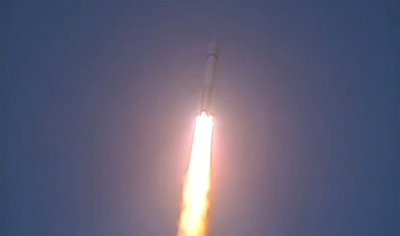Russian Proton Rocket Launches Three New Navigation Satellites

A Proton launcher rocketed into orbit Friday with three Glonass navigation satellites for the Russian government, delivering reinforcements for the military-run fleet of positioning and timing spacecraft.
Powered by six hydrazine-fueled main engines, the 191-foot-tall Proton rocket blasted off at 1251 GMT (8:51 a.m. EDT) Friday from a launch pad at the Baikonur Cosmodrome in Kazakhstan. The rocket soared into a dusk sky over Baikonur, where it was just after sunset.
Liftoff was supposed to occur Thursday, but a technical issue delayed the mission until Friday.
The three-stage Proton core launcher lofted the three Glonass satellites and a Breeze M upper stage into space in less than 10 minutes. The Breeze M rocket engine fired several times to reach an orbit 12,000 miles high with an inclination angle of 64.8 degrees to the equator.
The upper stage deployed all three satellites at 1841 GMT (2:41 p.m. EDT), according to Roscosmos, the Russian space agency.
Friday's launch was the 370th flight of a Proton rocket since it entered service in 1965. It was the seventh Proton mission this year.
Built by ISS Reshetnev Co., each Glonass M satellite weighs about 3,100 pounds at launch and has a design life of seven years.
Get the Space.com Newsletter
Breaking space news, the latest updates on rocket launches, skywatching events and more!
The Glonass system broadcasts navigation signals to Russian military and civilian users around the world. It is Russia's counterpart to the U.S. Air Force's Global Positioning System.
Friday's mission comes amid a flurry of fresh satellites for the Glonass fleet, which was restored to near full capacity by the launch of a single craft on a Soyuz rocket in early October.
Another Glonass satellite will launch on a Soyuz rocket Nov. 22, according to Roscosmos, the Russian space agency.
Updates on the Roscosmos website indicate the Glonass constellation includes 23 operational satellites as of Nov. 3, plus two spacecraft in maintenance, one next-generation platform undergoing flight testing, and one spare.
Russia says 24 satellites are necessary provide complete global navigation coverage.
The constellation is spread among three orbital planes, each designed to contain eight satellites to maximize coverage around the world.
Russia initiated a satellite replenishment program to mend the fragmented Glonass fleet after a funding crisis in the 1990s rendered the Soviet-era program unable to provide even limited coverage of Russian territory.
Copyright 2011 SpaceflightNow.com, all rights reserved.
Join our Space Forums to keep talking space on the latest missions, night sky and more! And if you have a news tip, correction or comment, let us know at: community@space.com.
Stephen Clark is the Editor of Spaceflight Now, a web-based publication dedicated to covering rocket launches, human spaceflight and exploration. He joined the Spaceflight Now team in 2009 and previously wrote as a senior reporter with the Daily Texan. You can follow Stephen's latest project at SpaceflightNow.com and on Twitter.










